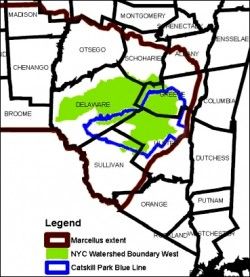Op-Ed: Hydrofracking Gamble Is a Gas, Gas, Gas

BETWEEN THE LINES: As drivers in Brooklyn feel the pinch of gas prices that have rapidly increased since the year began, there’s another energy source that doesn’t directly affect us for the time being, but deserves more than a gallon of interest.
Hydraulic fracturing, the process that extracts natural gas from shale with highly pressurized water — commonly labeled hydrofracking or fracking — was set to tap into huge underground reserves upstate until two court decisions derailed the projects. Those rulings were more than likely influenced after the Environmental Protection Agency reported late last year that water supplies in Wyoming were contaminated by the process.
If one thinks that an upstate venture or one thousands of miles away is not a local issue, think again. New York City uses billions of gallons of water every day that travels hundreds of miles to our homes via huge underground aqueduct systems – and the watershed is located in the Marcellus Shale, where frackers want to frack.
Since September 11, there has been concern that our drinking water may be vulnerable to a terrorist attack, so safety measures reportedly have been improved. Yet other internal dangers to our water supply exist. If fracking was measurably stepped up, it could pose a danger to our drinking water. With that in mind, two state court decisions last month upheld the right of local communities to prohibit gas drilling.
For years environmentalists and other opponents have warned that hydrofracking has the potential to pollute the air and contaminate water supplies. Several events in gas producing areas across the U.S. resulted in small tremors and may have been a tip-off that the fracking could lead, directly or indirectly, to an earthquake.
Most experts and lobbyists for an industry motivated by profits before public safety maintain that it is highly unlikely Mother Nature would ever react that way.
Moreover, red flags were raised in a handful of communities, including one as near as Pennsylvania, when residents and animals were diagnosed with medical problems that health officials attributed to the process.
In New York, fracking is banned near state watersheds, but it is feared that even outside those boundaries the procedure could result in leaks below the surface that impact the city’s water supply. Consequently, some consider any underground natural gas drilling as reckless.
Mayor Bloomberg has suggested a study be conducted to determine the minimum safe distance from our water supply for drilling to take place. He has argued that the current laws for no-drilling zones are not far enough away from the city’s drinking water supplies.
From the White House to your house it has long been acknowledged that the United States not only needs to reduce its dependency on Middle East oil, but to also develop safe, alternative and reasonably priced means of energy sources. Alternative energy sources, such as wind and solar power, may not pollute like fossil fuels have for over a century, but to start the ball rolling on a large scale it is projected they would be expensive and costly to consumers.
Others advocate more drilling and developing of home grown resources, like oil and natural gas, despite the inherent threats.
Though disasters from energy-producing missions are few and far between, they dominate the spotlight when they do occur. Domestic disasters, like the Exxon Valdez oil spill off the coast of Alaska more than a generation ago and the 2010 Deepwater Horizon disaster in the Gulf of Mexico, demonstrate that our energy needs sometimes come with a terrible price when the perils of extracting natural resources are overlooked by profit-driven businesses with awful public images.
Therefore, before underground procedures that produce contaminated wastewater and may cause leaks of hazardous materials near our reservoirs is accepted and regulated, those that stand to profit, including New York State from subsequent revenues, must assure the public that every possible safety measure is considered and in place. Naturally, there can never be a guarantee of safety or preventing an accident, but, at least, those measures should be substantially addressed to comfort public anxiety.
Drilling for gas may be one solution towards an independent energy policy, but it also comes with a myriad of potential troubles. To proceed with hydrofracking before methodically exploring the possible dangers, instituting adequate measures to safeguard our precious water supply and protecting the health of future generations, should neither be a knee-jerk decision nor a gamble we can afford to risk.
Neil S. Friedman is a veteran reporter and photographer, and spent 15 years as an editor for a Brooklyn weekly newspaper. He also did public relations work for Showtime, The Rolling Stones and Michael Jackson. Friedman contributes a weekly column called “Between the Lines” on life, culture and politics in Sheepshead Bay.




